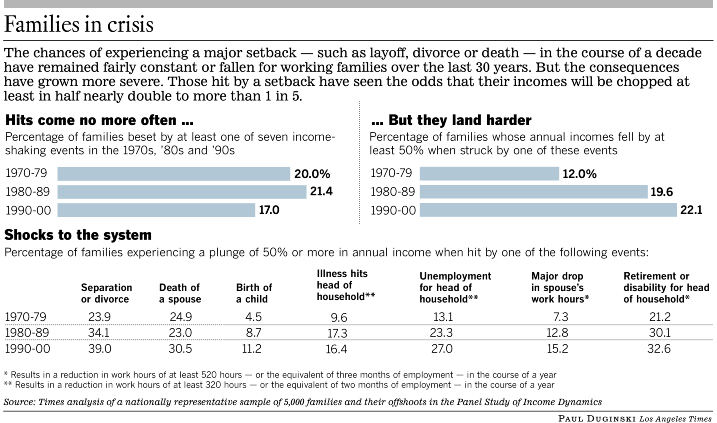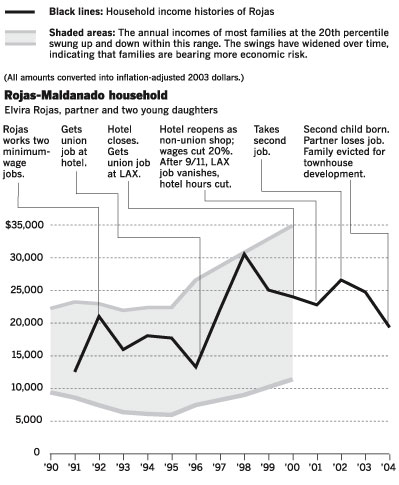Links
|
|
Links
| Segment 1: | 9:25 |
| Segment 2: | 13:31 |
Americans from the working poor to the traditionally affluent are living closer to the economic edge. One indicator is the growing swings in family income from year to year that have put some families on a roller coaster and left them vulnerable to financial disaster. NOW explores what is causing this new economic insecurity and asks what it says about the level of financial risk assumed by average Americans? In "Risky Business," NOW profiles two families dealing with the downside of this new economic reality. In the report, David Brancaccio with LOS ANGELES TIMES national economics correspondent Peter Gosselin analyzes a thirty-year pattern of cuts to benefits and worker protections that has shifted financial risks from government and business onto average Americans.
Family Stories
Peter Gosselin's "The New Deal" series made the statistics come to
life by profiling five families and their ups and downs in the changing
world of the American economic dream. NOW's story "Risky Business" caught
up with two of those families, the Ryans and Elvira Rojas and Jose Maldanado.
Click on the image below to chart the series of setbacks that colored the
economic world of Elvira Rojas.
"The stories of John Ryan and Elvira Rojas show how working Americans are leading economically riskier lives than they were 10, 20 or 30 years ago. It's not that they won't recover from their setbacks, but they're pretty much on their own to pull themselves back from the economic brink." -- Peter Gosselin
The statistics underlying Gosselin's LOS ANGELES TIMES series "The New Deal" were drawn from a unique ongoing economic tracking project, the Panel Study of Income Dynamics (PSID) at the University of Michigan which has followed the incomes of 5,000 plus nationally representative families and their offspring for almost forty years. Analysis of the statistics by the LOS ANGELES TIMES shows that families are increasingly vulnerable to the effects that crisis or change — losing a job, divorce, illness, death and birth — has on their income. The percentage of families that face these challenges hasn't varied much in the past thirty years, but the dips in the roller coaster ride are steeper and the recoveries that much more difficult. Click on the image below to see how families are faring when faced with setbacks.
Thirty years ago, most middle-class families' income rose or fell no more than $6,500 a year, in inflation-adjusted dollars. Today those incomes are going up and down more than $13,000 from year to year.

